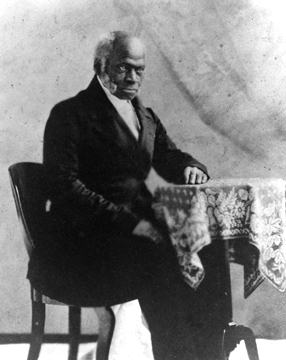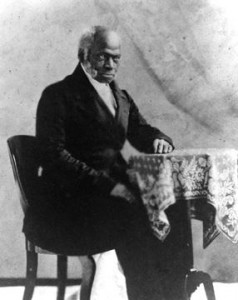
The line between West Indians and African-Americans was fuzzy…
Most of us already know that the slave trade circulated blacks between the U.S. and the Caribbean. We also probably know that after the Haitian Revolution, many Haitian slaveholders moved to Louisiana to start over, bringing their Haitian slaves with them. But West Indians also turned up in free states very early. By 1827, they were an important part of New York’s black community and participated in the black community’s grand Emancipation Day celebration. Jamaicans also fought in the Civil War — in Virginia’s 23rd U.S. Colored Infantry — alongside African-American Civil War soldiers, according to A Nation Under our Feet.
Pierre Toussaint is a prime example of the early West Indian immigration to the U.S. After the Haitian Revolution, he moved to New York with his masters, became a highly sought after hairdresser, successful business man and philanthropist.
At the same time, as previously discussed, African-Americans emigrated even en masse to the Caribbean. Much to the chagrin of those who would argue that West Indians are better than African-Americans or vice versa, these groups have been mixing and mingling for hundreds of years.
The Venerable Pierre Toussaint (1766 – June 30, 1853) was a former slave from the French colony of Saint-Domingue who was brought to New York City by his owners in 1787. There he eventually gained his freedom and became a noted philanthropist to the poor of the city. Freed in 1807, after the death of his mistress, Pierre took the surname Toussaint in honor of the hero of the Haitian Revolution which established that nation.
After his marriage in 1811, Toussaint and his wife performed many charitable works, opening their home as an orphanage, employment bureau, and a refuge for travelers. He contributed funds and helped raise money to build St. Patrick’s Old Cathedral, New York on Mulberry Street. He was considered “one of the leading black New Yorkers of his day.” His ghostwritten memoir was published in 1854.
Due to his devout and exemplary life, the Catholic Church has been investigating his life for possible canonization and in 1996 he was declared “Venerable” by Pope John Paul II, the second step in the process. Toussiant is the first layperson to be buried in the crypt below the main altar of St. Patrick’s Cathedral on Fifth Avenue, normally reserved for bishops of the Roman Catholic Archdiocese of New York .
Born into slavery in 1766 in Saint-Domingue (now Haiti), Pierre was the son of Ursule at the L’Artibonite plantation, and owned by the Bérard family. The plantation was located on the L’Artibonite River near Saint-Marc on the colony’s west coast. His father’s name is not known. He was known to have a sister Rosalie. His maternal grandmother, Zenobe Julien, was also a slave and was later freed by the Bérards for her service to the family. His maternal great-grandmother, Tonette, had been born in Africa, where she was sold into slavery and brought to Saint-Domingue. He was reared as a Catholic.
Pierre was educated as a child by the Bérard family’s tutors and was trained as a house slave. The senior Bérards returned to France, taking Zenobe Julien with them, and their son Jean Bérard took over the plantation. As the tensions rose which would lead to Haitian slaves and free people of color rising in rebellion, in 1787 Bérard and his second wife left the island for New York City, taking five of their slaves with them, including Pierre and Rosalie.
Upon their arrival in New York, Bérard had Pierre apprenticed to one of New York’s leading hairdressers. The master returned to Saint-Domingue to see to his property. After Jean Bérard died in St. Domingue of pleurisy, Pierre, who was becoming increasingly successful as a hairdresser in New York, voluntarily took on the support of Madame Bérard. His master had allowed him to keep much of his earnings from being hired out. (Pierre’s kindness to his mistress were noted by one of her friends, Mrs. Philip Schuyler, whose notes were a source for the 1854 memoir of Toussaint.) Madame Bérard eventually remarried, to a Monsieur Nicolas, also from Saint-Domingue. On her deathbed, she made her husband promise to free Pierre from slavery.
As a very popular hairdresser among the upper echelon of New York society, Toussaint earned a good living. He saved his money and paid for his sister Rosalie’s freedom. They both still lived in what was then the Nicolas house. After he was freed at age 45, Pierre took the surname Toussaint after Toussaint Louverture, the leader of the Haitian Revolution that had achieved independence for the slave republic in 1804.
Due to connections among the French emigrant community in New York, Toussaint met people who knew the Bérards in Paris. He began a correspondence with them that lasted for some decades, particularly with Aurora Bérard, who had been his godmother. The Bérards had lost their fortune in the French Revolution, during which Aurora’s father died in prison and her mother soon after. Her other siblings had married in France. Toussaint also corresponded with friends in Haiti; his collected correspondence filled 15 bound volumes, as part of documentation submitted by the Archdiocese of New York to the Holy See to support canonization.
In 1811 Toussaint married Juliette Noel, a slave 20 years younger than he, after purchasing her freedom. For four years they continued to board at the Nicolas house. They took in Euphemia, the daughter of his late sister Rosalie, who had died of tuberculosis, raising the girl as their own. They provided for her education and music classes. In 1815, Nicolas and his wife moved to the American South. Together the Toussaints began a career of charity among the poor of New York City, often taking baked goods to the children of the Orphan Asylum and donating money to its operations.
Toussaint attended daily Mass for 66 years at St. Peter’s in New York. He owned a house in Franklin Street, where the Toussaints sheltered orphans, and fostered numerous boys in succession. Toussaint supported them in getting an education and learning a trade; he sometimes helped them get their first jobs because of his connections in the city.
They also organized a credit bureau, an employment agency, and a refuge for priests and destitute travelers. Many Haitian refugees went to New York, and because Toussaint spoke both French and English, he frequently helped the new immigrants. He often arranged sales of goods so they could raise money to live on. He was “renowned for crossing barricades to nurse quarantined cholera patients” during an epidemic in New York.
Toussaint also helped raise money to build a new Roman Catholic church in New York, which became Old St. Patrick’s Cathedral on Mulberry Street. He was a benefactor of the First New York City Catholic school for Black children at St. Vincent de Paul on Canal Street.
As Toussaint aged, he continued his charity. At his death, his papers included records of his many charitable gifts to Catholic and other institutions; his character was lauded by friends and acquaintances. He was “one of the leading black New Yorkers of his day”, but his story became lost to history.
Euphemia died before her adoptive parents, of tuberculosis, like her mother. Juliette died in 1851. Two years later, Pierre Toussaint died on June 30, 1853, at the age of 87. He was buried alongside his wife and Euphemia, in the cemetery of St. Patrick’s Old Cathedral on Mott Street.
Juliette Noel was the wife of Pierre Toussaint and both consecrated their lives to helping the poor and doing charitable work. Juliette was born into slavery in 1786; she was held by a French family. Her freedom was purchased by Pierre before they married in 1811. They continued together the charitable works Pierre had begun. The couple helped refugees find jobs, cared for orphans, and opened a school to teach black children. They also provided financial help to the Oblate Sisters of Providence. When a plague struck the city of New York, they worked and cared for the victims. She died in 1851 in New York. Pierre was eighty-five years old at that time Juliette died. Some people support opening the beatification of Juliette, who they say served equally with Pierre.
After the formal approval by the Holy See of the cause for Toussaint’s canonization, his grave was located and identified in the cemetery where he had been buried. His remains were transferred to the crypt of St. Patrick’s Cathedral on Fifth Avenue, which serves as the seat of the Archbishop of New York

